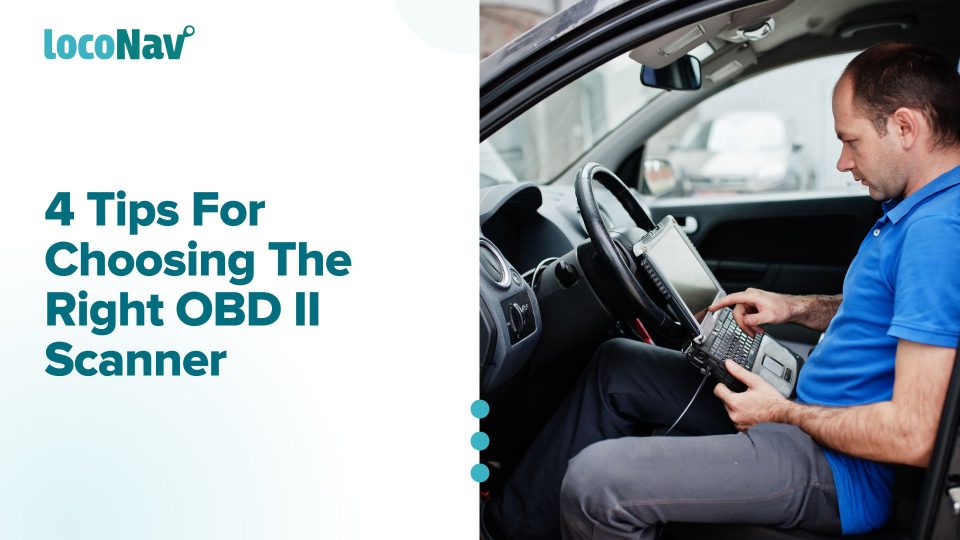

Seeing the dreaded “Check Engine” light blinking away on your vehicle dashboard is usually a hassle. It can be all the more aggravating to discover that the light came on due to a loose fuel cap, which you could have easily fixed. Would it not be much easier if you could figure out exactly what is wrong with your vehicle without driving it down to the service centre?
This is where an OBD II Scanner comes into play. By attaching this scanner to your fleet vehicles, you can easily perform basic diagnostics on your vehicle. These devices connect to your vehicle’s OBD port and read the data stored there. This data is analysed to determine the exact problem, such as an engine misfire, loose wires, or leaky fuel tanks. The exact issue can be inferred from the error codes that reflect via your OBD II Scanner.
While there are many benefits to using an OBD II Scanner, it is difficult to choose the right one for you. In this blog, we will give you some helpful tips that you can use to choose the right scanner for your fleet business.
What is an OBD II Scanner?
You may already be aware of this critical piece of technology, but if not, we will explain it quickly.
OBD stands for On Board diagnostics and is a typical computer network system in your vehicle. It is used to diagnose (or, more properly, self-diagnose) any problems with the vehicle and notify the relevant stakeholder.
You may be curious about how an OBD II scanner may vary from their forefathers, i.e., OBD-I scanners. The latter’s design and operation were OEM-specific, whereas their next generation makes use of comparable communication procedures, connectors, and code patterns. This enables the technology to be used in a broader range of vehicles of various makes and models.
What Is The Function Of An OBD II Scanner?
The common function of these devices is to read and clear engine trouble codes via your vehicle’s onboard diagnostics system. An OBD II scanner can also be used to read error codes from different vehicle systems, therefore providing real-time insights on the vehicle’s running state and more to help you diagnose difficulties, depending on the model you choose.
Manage your fleet efficiently with LocoNav’s Fleet Management Solutions!
Tips To Choose The Right OBD II Scanner
It can be difficult to determine which scanner is best for you if you are just starting out. Even if you know what features you want, determining which models are worth your money might be tough. Here are some tips that will help you get the most out of your OBD II scanner.
Tip #1 Decide What Information You Want From Your Device
The first thing you should think about is the data you want to collect from it – you must pick a scanner that covers the precise systems and functions that you require.
The functionality of basic scan tools is frequently limited. For example, if your vehicle’s ABS signal is illuminated, purchasing the cheapest diagnostic reader that just covers generic functions, such as emissions testing, will be ineffective.
A basic OBD-II code reader is a significant tool and may save your life, but it does not provide all of the sophisticated functions and features. Similarly, if all you need is to clear a check engine light, you do not need to purchase an expensive, professional-grade diagnostic tool.
Tip #2 Determine a Budget
The pricing of OBD-II scan instruments is very simple: the more you spend, the more functionality you get.
A simple OBD-II scanner does not provide complex diagnostic functions, but if generic OBD-II functions are all you require and you are looking for a basic scanner, an entry-level device is a terrific and extremely economical tool to have.
A tool that does not require a membership and comes with free lifetime upgrades, so there are no ongoing charges to utilise it is also a cost-saving option. However, because it allows you to conduct complex operations on all vehicle makes and models, it will be more expensive.
If you require a tool that can be used on all vehicle makes and models, you should consider purchasing a more advanced equipment.
Tip #3 Check Device Compatibility
Based on the signal computation mechanism, OBD II systems are classified into five kinds. As a result, you should always check for compatibility difficulties before the installation of one of these types in your vehicle.
Some products on the market may be advertised as 100% compatible, but it is always prudent to confirm this before purchasing.
Tip #4 Scope for Future Upgrades
Cheaper OBD II systems frequently do not allow for any form of upgrade. As a result, it is highly suggested that you go for high-end models, which may be a bit pricey at first but appear to be quite an excellent bargain in the long run if the model can be upgraded in the future.
Consider the case of a smartphone to understand the significance of renewing these diagnostic gadgets. You would upgrade apps on your phone to obtain improved features and usability, and you should do the same with these systems to acquire more features and be compatible with newer vehicle models.
